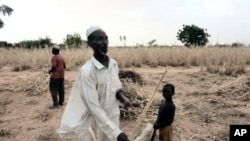Humanitarian workers say severe food shortages threaten more than six million people in Niger.
Aid agencies say funding is urgently needed to stave off a food crisis in the band of dry, drought-ridden territory that stretches from Senegal to Chad called the Sahel.
All together, United Nations agencies, including the World Food Program, are calling for just over $1 billion to head off the food crisis in the Sahel this year.
It has become an annual refrain in West Africa, and once again Niger's impoverished farmers and herders are at the epicenter of the crisis.
A coalition of U.N. agencies and six major international humanitarian NGOs says $229 million is needed to meet the needs in Niger alone.
Coalition spokeswoman, Gaelle Bausson, says as many as three million people in Niger have already depleted their food reserves with the next harvest still seven months away.
"They are migrating. They are selling their assets," she said. "They are selling their jewelry. They are selling their animals. The key element we are seeing right now, the key sign of the aggravation of the situation, is the children that are taken out of school because their parents are on the move or because their parents feel that right now the most important for the family is that the child participate in revenue-generating activities or seeking food or water for the entire family because they are really in a survival mode."
The U.N.- NGO coalition says more than 30,000 children have been taken out of school and almost 400,000 children may already be severely malnourished.
Niger is home to some of the poorest people in the world, and aid workers say a storm of factors this year have aggravated chronic food vulnerability. Those include soaring grain prices and irregular rainfall, as well as an influx of tens of thousands of Malian refugees fleeing the Tuareg rebellion.
Yet, aid efforts have been chronically underfunded in recent years in the Sahel. Many of those affected by this year's food shortages have not recovered from the last crisis in 2010.
Bausson said so far only 30 percent of the coalition's appeal has been funded.
"It means that there are going to be gaps, and gaps mean suffering for the people," she said."It means further aggravation. What we are looking at are people who are vulnerable slipping but surely, if action is not taken, into really severe conditions. Their health is deteriorating. They slip into severe malnutrition and then it is even more costly to act."
Prevention, she said, costs less than treatment. The coalition says it costs just one dollar to keep a child from slipping into malnutrition, whereas it costs $80 to treat that child once malnutrition has set in.
A severe drought in the Horn of Africa last year put 13 million people at risk of starvation. Oxfam International says as many as 100,000 people died as a result of delayed intervention, despite early warning signs.
In the Sahel, Bausson said there is still time to keep current food shortages from exploding into a full-blown humanitarian crisis.
News
Aid Agencies Sound Alarm on Niger Food Crisis
- By Anne Look









